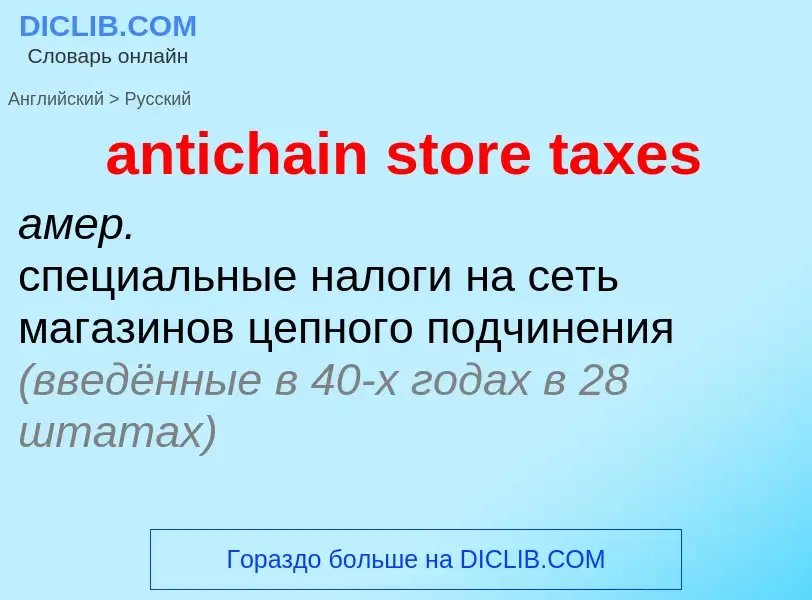Vertaling en analyse van woorden door kunstmatige intelligentie
Op deze pagina kunt u een gedetailleerde analyse krijgen van een woord of zin, geproduceerd met behulp van de beste kunstmatige intelligentietechnologie tot nu toe:
- hoe het woord wordt gebruikt
- gebruiksfrequentie
- het wordt vaker gebruikt in mondelinge of schriftelijke toespraken
- opties voor woordvertaling
- Gebruiksvoorbeelden (meerdere zinnen met vertaling)
- etymologie
antichain store taxes - vertaling naar russisch
специальные налоги на сеть магазинов цепного подчинения (введённые в 40-х годах в 28 штатах)
[dɪ'pɑ:tməntstɔ:]
общая лексика
универсальный магазин
универмаг
существительное
общая лексика
универсальный магазин, универмаг
Definitie
Wikipedia
In order theory, a subset A of a partially ordered set P is a strong downwards antichain if it is an antichain in which no two distinct elements have a common lower bound in P, that is,
In the case where P is ordered by inclusion, and closed under subsets, but does not contain the empty set, this is simply a family of pairwise disjoint sets.
A strong upwards antichain B is a subset of P in which no two distinct elements have a common upper bound in P. Authors will often omit the "upwards" and "downwards" term and merely refer to strong antichains. Unfortunately, there is no common convention as to which version is called a strong antichain. In the context of forcing, authors will sometimes also omit the "strong" term and merely refer to antichains. To resolve ambiguities in this case, the weaker type of antichain is called a weak antichain.
If (P, ≤) is a partial order and there exist distinct x, y ∈ P such that {x, y} is a strong antichain, then (P, ≤) cannot be a lattice (or even a meet semilattice), since by definition, every two elements in a lattice (or meet semilattice) must have a common lower bound. Thus lattices have only trivial strong antichains (i.e., strong antichains of cardinality at most 1).

![Aerial view of [[Anthony Hordern & Sons]] in [[Sydney, Australia]] (1936), once the largest department store in the world. Aerial view of [[Anthony Hordern & Sons]] in [[Sydney, Australia]] (1936), once the largest department store in the world.](https://commons.wikimedia.org/wiki/Special:FilePath/Anthony Hordern and Sons- 20th December 1936 (18832395934).jpg?width=200)
.jpg?width=200)
![[[Selfridges]], [[Oxford Street]] in [[London]], 1944 [[Selfridges]], [[Oxford Street]] in [[London]], 1944](https://commons.wikimedia.org/wiki/Special:FilePath/Christmas Party For Trooper Devereux's Daughter- Christmas in Wartime, Pinner, Middlesex, December 1944 D23005.jpg?width=200)
![former province of Echigo]]. The Mitsukoshi headquarters are located on the left side of the street. former province of Echigo]]. The Mitsukoshi headquarters are located on the left side of the street.](https://commons.wikimedia.org/wiki/Special:FilePath/Hiroshige, Sugura street.jpg?width=200)
![[[Sokos]] department store building in [[Multimäki]], [[Kuopio]], Finland [[Sokos]] department store building in [[Multimäki]], [[Kuopio]], Finland](https://commons.wikimedia.org/wiki/Special:FilePath/Kuopion Sokos2 - Haapaniemenkatu 24-26 - Multimäki - Kuopio - m.jpg?width=200)

